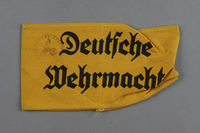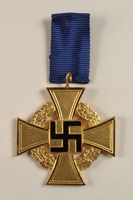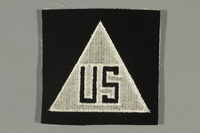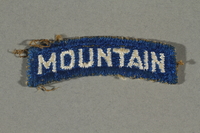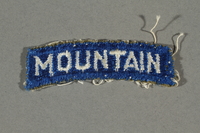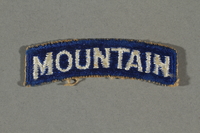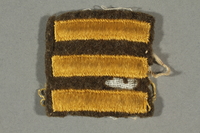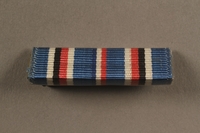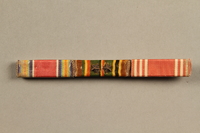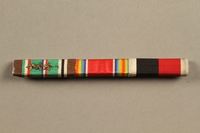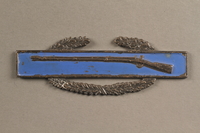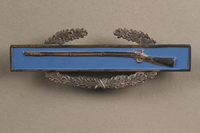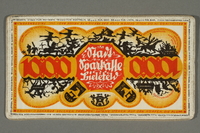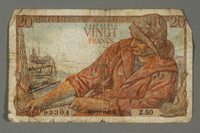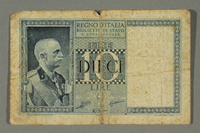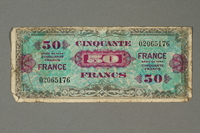Overview
- Brief Narrative
- Bronze Star medal with the name Gerald Schwab inscribed on the reverse, along with a lapel pin, certificate from the War Department, and the accompanying box.
- Credit Line
- United States Holocaust Memorial Museum Collection, Gift of Gerald Schwab
United States Holocaust Memorial Museum Collection, Gift of Susan Schwab and Teresa Marshall
Physical Details
- Classification
-
Awards
- Category
-
Medals
- Object Type
-
Medals--United States (lcsh)
- Physical Description
- Bronze Star medal and ribbon (a) with the name Gerald Schwab inscribed on the reverse, along with a lapel pin (b), certificate from the War Department (c), and the accompanying box (d).
- Dimensions
- a: Height: 3.000 inches (7.62 cm) | Width: 1.500 inches (3.81 cm)
b: Height: 0.380 inches (0.965 cm) | Width: 1.380 inches (3.505 cm)
c: Height: 3.000 inches (7.62 cm) | Width: 5.000 inches (12.7 cm)
d: Height: 0.880 inches (2.235 cm) | Width: 3.500 inches (8.89 cm) | Depth: 6.500 inches (16.51 cm) - Materials
- a : metal, cloth
b : metal, cloth
c : paper
d : leather, cloth, paint, metal - Inscription
- reverse of medal: name Gerald Schwab inscribed
Rights & Restrictions
- Conditions on Access
- No restrictions on access
Administrative Notes
- Legal Status
- Permanent Collection
- Provenance
- The medal was donated to the United States Holocaust Memorial Museum in 2016 by Ambassador Susan Schwab and Ms.Teresa S. Marshall.
- Record last modified:
- 2022-07-28 18:15:18
- This page:
- https://collections.ushmm.org/search/catalog/irn555961
Download & Licensing
In-Person Research
- By Appointment
- Request 21 Days in Advance of Visit
- Plan a Research Visit
- Request to See This Object
Contact Us
Also in Gerald Schwab collection
The collection consists of artifacts and documents relating to the experiences of Gerald Schwab
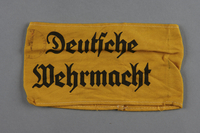
Armband
Object
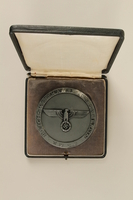
Medal
Object
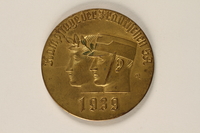
Medal
Object
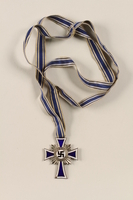
Cross of Honor of the German Mother medal, 2nd Class Order, Silver Cross
Object
The Mother's Cross was instituted by the Nazi Party in 1938. It was first awarded in 1939 to some 3 million mothers as a propaganda measure to promote National Socialist population policy.
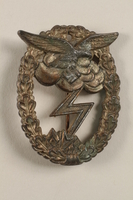
Pin
Object
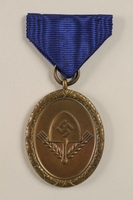
German Worker's medal
Object
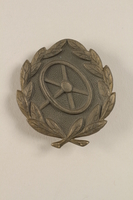
Pin
Object
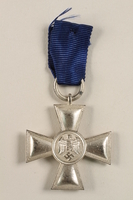
Medal
Object
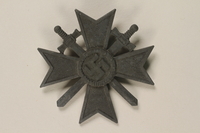
Pin
Object
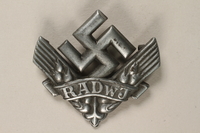
Pin
Object
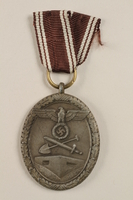
Westwall Defense medal
Object

Iron Cross Pin
Object

Pin
Object
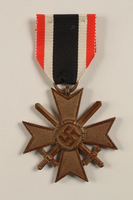
War Service Cross Medal
Object
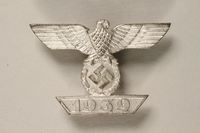
Pin
Object
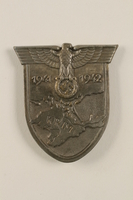
Crimean campaign pin
Object
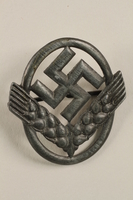
RAD hat pin
Object
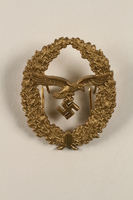
Shooting badge pin
Object
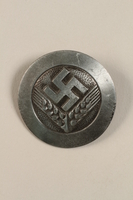
RAD pin
Object
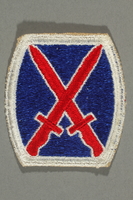
Badge
Object
Fabric badge depicting crossed red swords against a blue background, with a white border.

Badge
Object
Fabric badge depicting crossed red swords against a blue background, with a white border.
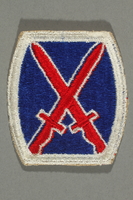
Badge
Object
Fabric badge depicting crossed red swords against a blue background, with a white border.
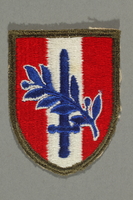
Badge
Object
Shield-shaped fabric patch with red and white stripes and an olive branch crossed with a sword.
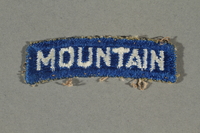
10th Mountain Division tab worn above the divison's uniform patch
Object
Rectangular, blue fabric tab for the 10th Mountain Division, which would be worn above the division's patch on a uniform.

Pin
Object
Oval shaped painted metal pin with crossed swords and a military helmet, ringed by a laurel wreath.
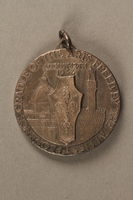
Liberation of Florence medal
Object
Round metal medal commemorating the liberation of Florence on August 12, 1944. The words "Florence/Cradle of the Arts/Freed by the Allies" along with images of famous Florentine buildings on one side and the words "Democracy/Prosperity/Freedom" and three flags, including British and American flags, on the other.
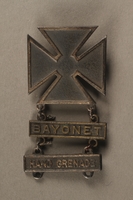
Medal
Object
Cross shaped pin-backed medal with hanging bars with words "Bayonet" and "Hand Grenade."
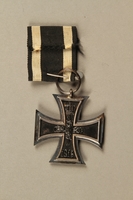
Iron Cross medal with box
Object
WWI Iron Cross medal with blue and white striped ribbon and accompanying box.
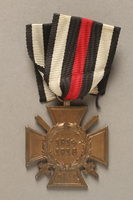
WWI Iron Cross medal with ribbon
Object
Iron Cross medal with red, white and blue striped ribbon attached to loop on medal.
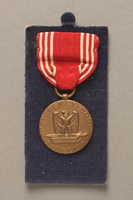
American Army Good Conduct medal
Object
Round medal with eagle perched on a sword and a closed book. Around the outside are the words, “EFFICIENCY, HONOR, FIDELITY.” The reverse of the medal has a five pointed star just above center with a blank scroll. Above the star are the words, “FOR GOOD” and below the scroll is the word, “CONDUCT.” A laurel wreath surrounds the design. A red and white striped ribbon is attached to the medal, which is pinned to a cardboard/blue fabric backing.
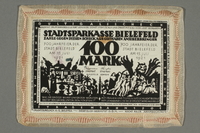
Linen notgeld
Object
100 Mark German emergency currency, or "notgeld" printed on linen. The currency is dated 15 July 1921.
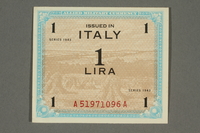
1 Lira Allied Military Currency
Object
1 Lira Allied Military Currency issued in Italy in 1943. Serial number A 51971096 A.
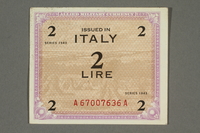
2 Lira Allied Military Currency
Object
2 Lira Allied Military Currency issued in Italy in 1943. Serial number A 67007636 A.
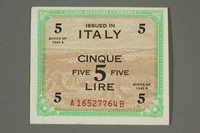
5 Lira Allied Military Currency
Object
5 Lira Allied Military Currency issued in Italy in 1943. Serial number A 16527764 B.
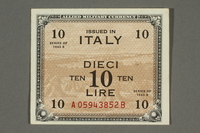
10 Lira Allied Military Currency
Object
10 Lira Allied Military Currency issued in Italy in 1943. Serial number A 05943852 B.
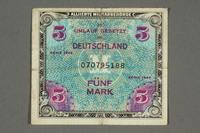
5 Mark Allierte Militarbehorde currency
Object
5 Mark Allierte Militarbehorde currency, series 1944. Serial number 070795188.
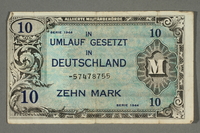
10 Mark Allierte Militarbehorde currency
Object
10 Mark Allierte Militarbehorde currency, series 1944. Serial number 57478755.
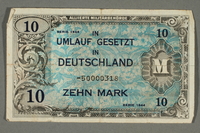
10 Mark Allierte Militarbehorde currency
Object
10 Mark Allierte Militarbehorde currency, series 1944. Serial number 50000318.
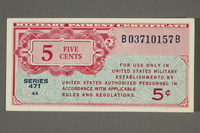
American 5 Cent military payment certificate
Object
American 5 Cent military payment certificate, serial number B 03710157 B.
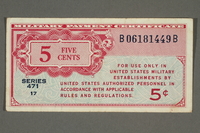
American 5 Cent military payment certificate, serial number B 06181449 B.
Object
American 5 Cent military payment certificate, serial number B 06181449 B.
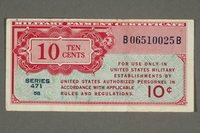
American 10 Cent military payment certificate
Object
American 10 Cent military payment certificate, serial number B 06510025 B.
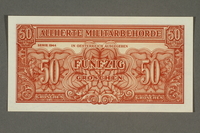
50 Groschen Allierte Militarbehorde currency
Object
50 Groschen Allierte Militarbehorde currency, series 1944.
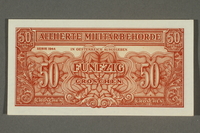
50 Groschen Allierte Militarbehorde currency
Object
50 Groschen Allierte Militarbehorde currency, series 1944.
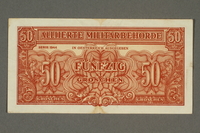
50 Groschen Allierte Militarbehorde currency
Object
50 Groschen Allierte Militarbehorde currency, series 1944.
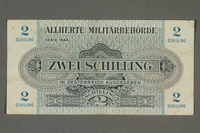
2 Schilling Austrian Allierte Militarbehorde currency
Object
2 Schilling Austrian Allierte Militarbehorde currency, series 1944.
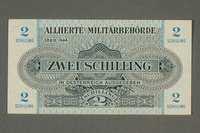
2 Schilling Austrian Allierte Militarbehorde currency
Object
2 Schilling Austrian Allierte Militarbehorde currency, series 1944.
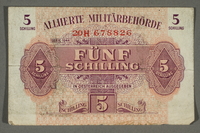
5 Schilling Austrian Allierte Militarbehorde currency
Object
5 Schilling Austrian Allierte Militarbehorde currency, series 1944. Serial number 20H 678826.
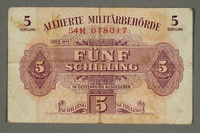
5 Schilling Austrian Allierte Militarbehorde currency
Object
5 Schilling Austrian Allierte Militarbehorde currency, series 1944. Serial number 54H 078017.
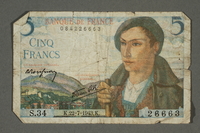
French 5 Franc scrip
Object
French 5 Franc scrip. Issued by the Bank of France. Serial number 084226663.
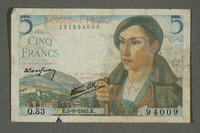
French 5 Franc scrip
Object
French 5 Franc scrip. Issued by the Bank of France. Serial number 131594009.
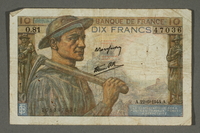
French 10 Franc scrip
Object
French 10 Franc scrip. Issued by the Bank of France. Serial number 201347036.
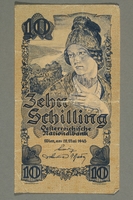
10 schilling Austrian scrip
Object
10 schilling scrip issued by the Oesterreichische Nationalbank in Vienna, 29 May 1945.
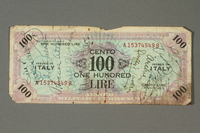
100 lire scrip
Object
100 lire scrip, series 1943, issued in Italy as Allied Military Currency. The scrip has several signatures on the front.
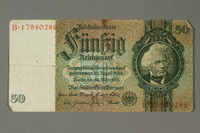
50 Reichsmark scrip
Object
German 50 Reichsmark scrip, serial number B 17940286, issued in Berlin in March 1933.
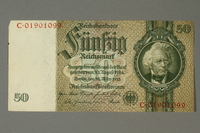
50 Reichsmark scrip
Object
German 50 Reichsmark scrip, serial number C 01901099, issued in Berlin in March 1933.
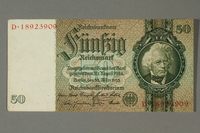
50 Reichsmark scrip
Object
German 50 Reichsmark scrip, serial number D 18923909, issued in Berlin in March 1933.
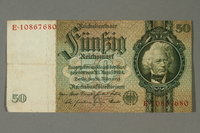
50 Reichsmark scrip
Object
German 50 Reichsmark scrip, serial number E 1867680, issued in Berlin in March 1933.
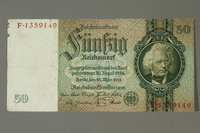
50 Reichsmark scrip
Object
German 50 Reichsmark scrip, serial number F 1359149, issued in Berlin in March 1933.
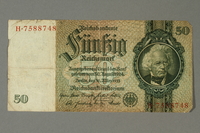
50 Reichsmark scrip
Object
German 50 Reichsmark scrip, serial number H 7588748, issued in Berlin in March 1933.
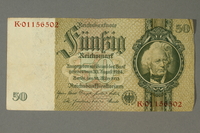
50 Reichsmark scrip
Object
German 50 Reichsmark scrip, serial number K 01156502, issued in Berlin in March 1933.
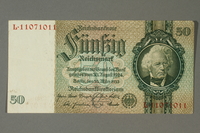
50 Reichsmark scrip
Object
German 50 Reichsmark scrip, serial number L 11071011, issued in Berlin in March 1933.
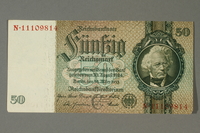
50 Reichsmark scrip
Object
German 50 Reichsmark scrip, serial number N 11109814, issued in Berlin in March 1933.
Box
Object
Gerald Schwab papers
Document
The Gerald Schwab papers document Schwab’s work for the International Military Tribunal following World War II; research for his books The Day the Holocaust Began: The Odyssey of Herschel Grynszpan and OSS Agents in Hitler's Heartland: Destination Innsbruck; his efforts to receive restitutions for Holocaust-era losses; biographical, genealogical, and photographic materials documenting Schwab and his family; and audiovisual and electronic records documenting Schwab’s interests in Holocaust-era topics. International Military Tribunal records include trial documents, photographs and illustrations, personal records, and correspondence documenting Schwab’s work at the Nuremberg trials. Trial documents include material used in conjunction with the Nuremburg trials such as witness lists, a document stating the mental competency of Rudolf Hess, and summaries of the days in court. Photographs and illustrations consists of photographs, ranging from the Palace of Justice and the courtroom itself to the Doctor’s Trial (United States of America vs. Karl Brandt, et. al.) and court officials. Photographs include small and large prints of the defendants and the prosecutors and a photo album with larger prints of the International Military Tribunal in action, with captions explaining the various scenes. Also included are caricature sketches of the defendants by German newspaper caricaturist, Peis. Personal documents include correspondence created by Gerald Schwab while working for the International Military Tribunal, passes to the trials, a list of the medals and pins he donated to the United States Holocaust Memorial Museum, orders, and related items. Correspondence includes Schwab’s personal letters describing his Nuremberg work to relatives and friends, subsequent efforts to collect documents related to the trials, and a 45th anniversary reunion of Nuremberg staff. Records related to The Day the Holocaust Began: The Odyssey of Herschel Grynszpan include Schwab’s correspondence, publishing records, research files, and writings created during his research into Grynszpan’s assassination of Ernst vom Rath and the publication of his book on the same topic. Correspondence includes letters exchanged with researchers and individuals interested in the Grynszpan case as well as with research institutions holding relevant records. Publishing records document the process of the book’s publication and include correspondence with publishing firms, legal records, announcements and reviews, endorsements for the book, and correspondence with production companies about the possibility of making a film based on the book. Research files include manuscripts about Herschel Grynszpan by Alain Cuenot and Friedrich Grimm, articles and clippings about Grynszpan, reproductions of original source material, and some of Schwab’s notes and lists of sources. Occupation Greenup records document Schwab’s research into Operation Greenup, a mission that parachuted three German-speaking spies into the area around Innsbruck to investigate Nazi fortifications and track their movements. Records include drafts of articles and chapters, a letter from Fred Mayer, notes, photographic materials (photographs, negatives, and copy prints), postcards of Ambergerhütte and Oberperfuss, printed materials (originals and photocopies), research materials, information about Schwab’s 2006 Rotteck Gymnasium visit, and tourist information and maps. Restitution paperwork consists of correspondence, forms, financial records, and legal records documenting the Schwab family’s efforts to receive compensation for money and property confiscated during the Holocaust. Claims relate to personal property and valuables, immigration costs, taxes, pensions, and family businesses registered in Germany, Switzerland, and France. Biographical and genealogical materials include identification papers; birth, marriage, and death certificates; immigration and travel records; military service records; employment records; family trees and genealogical research documenting the Schwab family. Loose photographs, copy prints, and negatives depict Gerald Schwab and his family during his childhood in Breisach, Germany, his military career, his postwar work in Europe, his wife and children, and his diplomatic career. Two small photograph albums also depict Gerald Schwab and his family during his childhood in Breisach. Audiovisual and electronic records include audiocassettes, floppy disks, CDs, and DVDs documenting interviews, exhibits, commemorative events, related to Herschel Grynszpan, Kristallnacht, the Holocaust, the Nuremberg trials, and Gerald Schwab’s writings.

